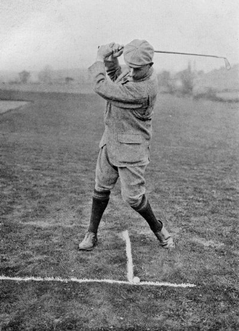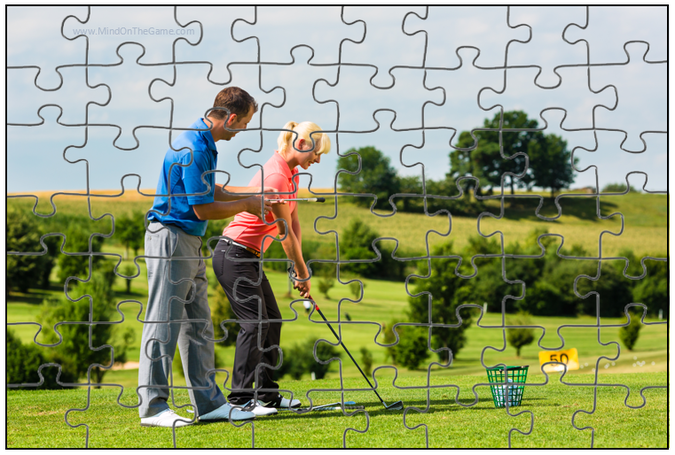|
Is golf a difficult game to get good at? Now, consider that some in the golf instruction community might respond to that opening question by exclaiming that it’s not a difficult game to learn, if you learn it the ‘right’ way. Other's at the other end of the spectrum might say it is a very difficult game to get good at. There's no doubt that some will pick the game up and get good at it really quickly. Still, there are others who struggle with it, over and over, and never seem to make progress. Golf might just be an easier game to learn, if you learn the right way. The trouble is that the right way is often presented, or communicated, the wrong way. Are you confused yet... Well you will be after the next sentence... What I'm saying is that "the map is not the territory." Huh?... This interesting phrase was coined in the 1950's by Alfred Korzybski who was founder of General Semantics. One of the pre-suppositions of NLP, the map is not the territory is a metaphor that describes the differences between a persons beliefs (the maps) and their reality (the territory). Our perception of the world around us is being constantly generated by our brain, and can be considered as a kind of 'map' of reality written in neural patterns. (Source: https://wiki.lesswrong.com/wiki/The_map_is_not_the_territory)  Golf for many, is a difficult game to get good at because there seems to be many ‘right ways,’ or, different maps, for explaining how to travel through the golf territory safely. The map for a golfer teacher/instructor or coach describes their unique concept of, and description of golf basecon their experience, including--but not limited to what they consider their fundamentals of golf to be, and how they should be taught. Since every person playing golf experiences it differently, there will always be a multitude of ways of how to describe it, how to teach it, how to play it, and how to get good at it. One thing we can be pretty certain about, is that it seems like golfers who make continual progress, tend to work with instructors who use better or more effective maps. We consider that golf teachers who use better maps with their students, to be more flexible and adaptable with their communication style, to adjust to the differences in golfers learning styles and preferences, their beliefs and values, and their potential for improvement. The territory or reality part is that golf is a stick and ball game. This is the same for every golfer. It's not unlike many other stick and ball games, with the exception that most of these games are played with a moving ball. Golf, is played with a stationary ball. That makes it more like croquet, than say ice or field hockey.  Action You Make, Not Reaction You Take It also means that the thinking process in golf is different, in that it’s more about the action you make, rather than the reaction you take. A person playing golf must go through some sort of mental process to get themselves ready to strike a stationary ball, which is something people playing sports with a moving ball do differently. The other factor that has an influence on how the game is played is that many stick and ball games are played over a much shorter duration, often with a higher physical intensity component. Golf is played over a much longer duration, with a lower—intermittent physical intensity. In other words, instead of running around a field or court, golfers are often walking hundreds of yards between each strike of the golf ball. Also, many stick and ball sports are team sports, where you are sharing the experience of playing the game with team members, and collaborating with them to score as many points as possible. In golf, you are playing by yourself, even if you have playing partners. Your score is based on your ability to use a variety of skill sets in different and changing conditions to score as low as you can. Whereas many stick and ball games are played on a consistent and predictable playing surface—such as a tennis court, golf is played on an inconsistent and unpredictable playing surface.  Physical/Technical Intelligence or... A useful definition of learning is; the acquisition of knowledge through study, experience, or being taught. Golf is not a game of facts to be remembered though, it’s a game of highly specific physical/technical movements, with a golf club and ball, that you perform in an ever-changing environment full of various types of interference. Learning golf skills requires a kind of physical/technical intelligence, or what Professor Howard Gardner (of Multiple Intelligence's Theory) describes as Bodily-Kinesthetic Intelligence. The core elements of his Bodily-Kinesthetic Intelligence are control of one's bodily motions, and the capacity to handle objects skilfully. Professor Gardner expands on this to suggest that this also includes a sense of timing, a clear sense of the goal of a physical action, along with the ability to train responses. People who have high Bodily-Kinesthetic Intelligence should be generally good at physical activities such as sports, dance, acting, and making things. (Source: https://en.wikipedia.org/wiki/Theory_of_multiple_intelligences) So, this physical/technical intelligence that you acquire through practice, allows you to perform complex muscle-and-nerve actions that produce highly specific movements with your body and golf club, to propel golf balls towards pre-determined targets. This specific type of motion is described as a motor-skill, and the fine motor skills are the small body-club movements that you make to hit putts or chip shots, and the gross motor skills are the larger body-club movements you use to make full swings with a driver. Now, you can go to driving ranges and practice fairways the world over, and you will see golfers who competently swing golf clubs and striking golf shots with a reasonable degree of control.  It's Still a Stick and Ball Game The basic premise of the game hasn’t changed in centuries. Basically, the ball is on the ground in front of you and you learn a variety of backwards-and-forwards strokes (short and long) with different clubs, to strike a ball, and you adapt those strokes to the changing conditions of the golf course, to score as low as you can against the par of each hole. That seems like a reasonable definition, doesn’t it? Where do you learn those different strokes however? In most cases, it is not on the inconsistent playing surface you will play on, and possibly compete on, but usually somewhere quite removed from that environment. This one factor alone explains why learning and performing at golf is quite different to most other sports, where you learn the sport in the environment that you compete in, i.e. you learn tennis on a tennis court, and you learn basketball on a basketball court. It is likely that the environment where you learn those golf strokes is relatively flat in nature, it could be synthetic, as opposed to organic, and it probably lacks the various types of interference that you confront on the golf course, such as tree’s, bunkers, hazards and water hazards, varying slopes and ground conditions, not to mention the weather conditions too. Those interference's are crucial—especially early into the learning and development process, because they influence how you adapt, acquire, and develop your ‘how to play golf,’ intelligence. Think about that for a moment… You see, we need to be challenged continually to grow, and adaptation is a basic requirement for growth. How do you learn to develop your 'how to play golf' intelligence in an artificial environment that is devoid of interference? Well, you will adapt, that is for certain, but probably not in the way that helps you to improve your game on the golf course. For many golfers, in our experience, this lack of the right type of learning experience, ends up becoming a gigantic obstacle that few ever really get beyond. "Physical / technical skill based learning must be integrated into an emotional intelligence framework, because golfers are sentient (emotional) beings-first and foremost, and certainly not humanoids." Imagine for a moment that a promising golfer was learning how to play golf in an environment that excluded all the interferences that they would face on the golf course? This golfer could be quite capable of executing the various golf strokes they are being taught by their instructor. However, when they go onto the golf course with these well-practiced physical skills and they encounter these different forms of external interference, it is likely that they will struggle to adapt. Not to physically or technically adapt, but to emotionally adapt—the internal adaptation. You see, even though some golf instructors believe that golf (the external game) is an easy game to learn, the reality for many is that it is far from easy to learn, and improve, because golfers are not just thinking beings who acquire physical golf skills to play the game, they are also emotional beings. In-fact, emotions underpin and dictate everything a golfer does on the golf course, from decision making to execution. Golfers need more than just a whole range of physical techniques to play golf, they need to develop their emotional intelligence techniques also.  You Are Human, Not a Humanoid So, we argue that it is not enough to learn physical/technical skills almost as if you program a golfer like a computer, where the golfer receives raw input data in the form of ‘how to’ instruction, such as learning P1, P2, P3 etc. and then is asked to perform more like a humanoid, than a human being. Physical/technical skill based learning must be integrated into an emotional intelligence framework, because golfers are sentient (emotional) beings-first and foremost, and certainly not humanoids. Learning and playing golf is much more of a humanistic (holistic) experience than it is a mechanistic (technical-deterministic) experience. So, golfers must learn how to translate and transfer their physical/technical skills confidently into emotional readiness, to confront the different situations they face on the golf course. In next months article we will introduce our Golfer Emotional Intelligence Framework that will show you how to integrate emotional intelligence into your physical/technical model. Lawrie Montague and David Milne - Pro Tour Golf College Jakarta, Indonesia Comments are closed.
|
Archives
June 2019
|
Proudly Supported By
Copyright © 2011 - 2018 Pro Tour Golf College
Website Managed By Golf Performance Media
All Rights Reserved
Website Managed By Golf Performance Media
All Rights Reserved





 RSS Feed
RSS Feed



